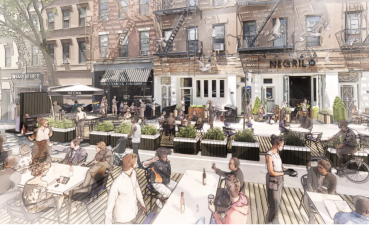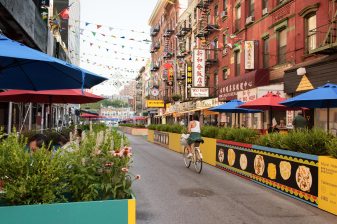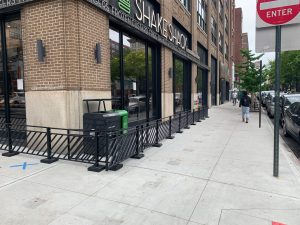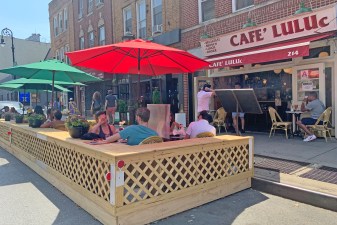City Hall to Create Space for Outdoor Dining When Phase 2 Starts — But When is That?!
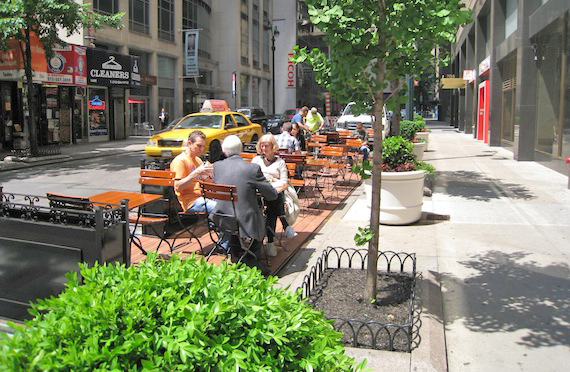
Don’t make your reservations just yet.
Mayor de Blasio has unveiled a plan for letting eateries use miles of public space to jumpstart the economy once the state gives the city the green light on Phase II of its reopening plan — which the mayor repeatedly said on Thursday would not start until “the beginning of July” even though Gov. Cuomo had set the tentative date of June 22, at least 10 days earlier.
The announcement, which had many wins for restaurateurs, was still disappointing because of how deliberately the mayor continues to move, first dismissing the call for outdoor restaurant space for several weeks, then putting it off further, into July.
“July is a tragedy for the restaurant business,” said Henry Rinehart, who is spearheading the industry’s effort to create space for restaurants in the era of social distancing. “It’s too late. The governor said June 22 — I had a restauranteur crying on the phone today when I said the mayor said July.”
Rinehart and others did see many positives in the mayor’s framework:
Sidewalk rules
- Restaurants will be able to “use the roadbed alongside the curb for dine-in service,” a rare permission from the de Blasio administration to repurpose space commonly used by drivers for free car storage.
- There will be a simple process to register and self-certify online, the mayor said.
- Obviously, fire hydrants and bus stops cannot be blocked. Seating must be “located away from intersections.”
- Restaurants must provide their own vertical barricades, planters, tables, and chairs.
Open street rules
- Restaurants can create seating areas directly in front of their establishments on any of the existing open streets, which number about 35 miles.
- The city said it would also “identify new open streets on commercial strips with large number of restaurants and bars.”
Sidewalk cafes
- The city said it would “create a simpler, streamlined process for sidewalk seating that would require establishments to maintain appropriate clear paths for pedestrians and people with disabilities.”
(The plan makes no provision for street food vendors, whose numbers are currently capped. The Street Vendor Project recently demanded inclusion in any open streets plan.)
“New York’s restaurants are part of what make us the greatest city in the world,” the mayor said on Thursday. “They’ve taken a hit in our fight against COVID-19 – and there’s no recovery without them.”
He said the “Open Restaurants plan” would balance the need for social distancing while allowing businesses to make a reasonable profit. Restaurateurs had told the city that a preliminary proposal to allow eateries to reopen, but only at 25-percent capacity, would not work.
“Once the city enters Phase II, restaurants will be able to serve customers in outdoor seating areas without enduring a cumbersome application and approval process,” a City Hall statement claimed.
The mayoral announcement came one week after the City Council forced his hand by proposing legislation that would have required the city to create sidewalks, streets, and plazas for outdoor dining with a “fast, simple” permitting process.
The mayor said at the time that he was not ready to move ahead even as other cities had started the process. In fact, Hizzoner said that his deliberate style was a “badge of honor,” even as restaurateurs were begging for relief now that the weather is better and revenue is just sitting out there to be collected.
He could have moved boldly, but declined. But on Wednesday, Gov. Cuomo gave de Blasio the impetus to move forward by saying that restaurants could be part of the state’s Phase II reopening, but leaving the rules up to municipalities. Indoor dining will be part of Phase III, whose opening is unclear.
“It’s a complete de Blasio moment,” said Rinehart. “He wasn’t going to do it at all, then the governor forces him to do something, and then he puts out a sketch. It looks like it was concocted in 12 hours — and it shows.”
Rinehart did hail the self-certification standards in the plan.
“You have to trust someone in a crisis. Trust restaurants to do what is asked,” he said.
Rinehart also said the plan can only be successful if it creates far more open space than the mayor imagines. Currently, the city is on pace to open up 100 miles of its 6,000 miles of roads for social distancing, plus whatever new space is identified for restaurants, but it is unlikely to ever get into the mid-three figures.

“We need 1,000 miles of open streets,” Rinehart said. “If you want to do business, you do business. One hundred miles doesn’t do anything for anyone.”
Activists were pleased that the mayor was finally moving forward on the larger issue: making space available for restaurants that otherwise would be sewers for cars. But their pleasure was short-lived. Transportation Alternatives Executive Director Danny Harris was initially quoted in the official City Hall press release as saying the open restaurant plan was a “bold initiative.”
But later he had to backtrack a bit because he had some of concerns:
“As this program advances, we call on Mayor de Blasio to prioritize the public right-of-way and keep the program’s enforcement and oversight out of the hands of the NYPD,” Harris said.
He continued:
Any additional space for dining must be taken from driving lanes or parking spaces, and never at the expense of bus lanes, bike lanes, or pedestrian space. If new outdoor dining spaces are located on sidewalks, an equivalent measure of road space should be turned into space for walking. The city must not eliminate public space in implementing Open Streets; to do so would defeat the purpose of this program.
In addition, we urge Mayor de Blasio to lift caps on street vendor licenses, so those smallest of businesses, which are predominantly run by immigrants and people of color, can wholly participate in “Open Restaurants.”
For his part, famed restaurant architect David Rockwell, who created mock-ups that may have helped push the mayor to envision roadways for eateries, approved of de Blasio’s move, and said he can’t wait to “test design standards at locations citywide.”
Rockwell, of course, is not the only architect thinking in this space. Brooklyn-based designer Julie Torres Moskovitz sent over her gorgeous renderings for public space that includes vendors.
“We are thinking more block party and community — relaxing together,” she said.

City officials did not initially respond to a welter of questions from Streetsblog. We will update this story if they do.

